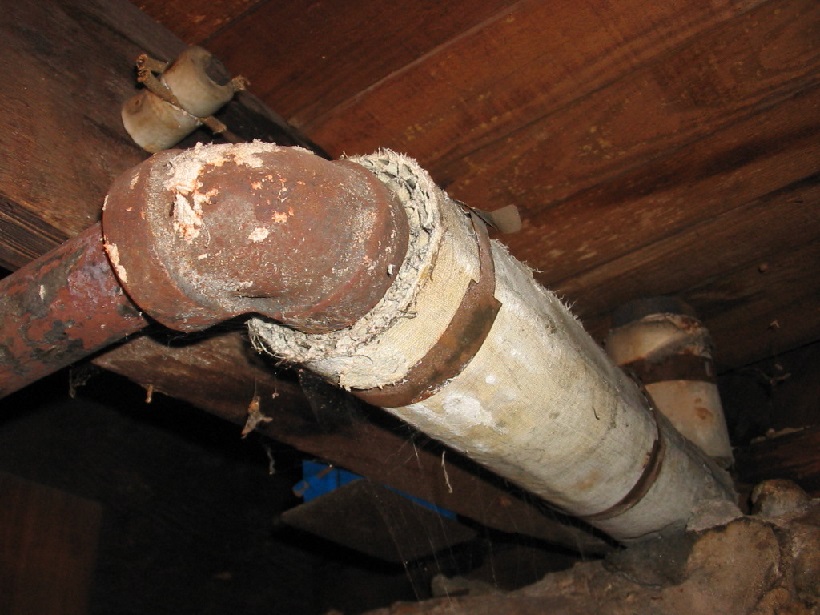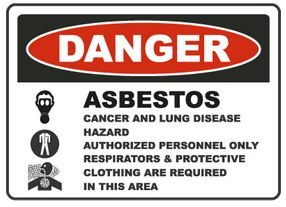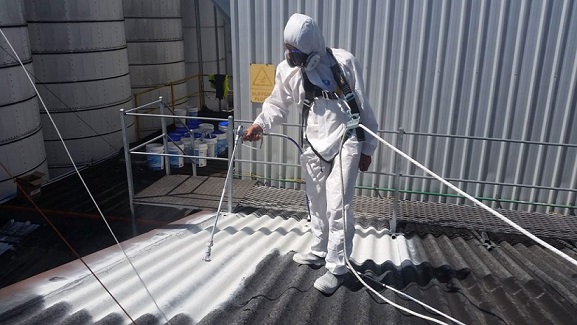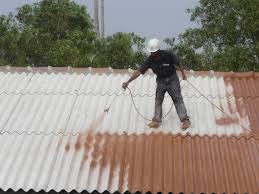Asbestos has been a topic of discussion since the turn of the millennium, but confusion still surrounds this material and the associated risks.
Our inbox is consistently flooded with inquiries from readers seeking guidance on asbestos in their homes and what steps to take if they come across it. The challenge lies in the fact that not everyone can readily identify asbestos or understand the proper protocols for handling it.
To address these concerns, we've compiled a comprehensive guide on dealing with asbestos in your home. This resource covers a brief history of the material, potential health risks, what actions to take upon discovery, and the potential costs associated with removal.
Given that asbestos demands careful handling, it's crucial to stay informed. Join us as we delve into everything you need to know to ensure a safe living environment in your home.

Contents
Introduction
A Short History Of Asbestos And Its Uses
Different Types Of Asbestos And Common Uses
When Should Asbestos Be Removed?
How To Remove Asbestos
How Much Does Asbestos Removal Cost
Asbestos Testing
Seeking Help From Your Local Authority
A Short History Of Asbestos And Its Uses
From the 1930s right through to 1999, asbestos was commonly used in construction due to its fire resistance and heat insulation properties. The material is a mineral fibre and if inhaled after being released into the air can lead to serious health problems. This has led to a complete ban on the use of asbestos in the construction industry in the UK and across the world.
For any house built before 1999, asbestos could be present within the structure. In many cases its presence will be completely harmless as long as it is left undisturbed. However, most property owners choose to completely remove all traces of asbestos.
The Health and Safety Executive (HSE) state that asbestos materials in good condition are considered safe. If the fibres become airborne – which is what happens when the material is damaged – it is then considered a health risk. These tiny particles are linked to a number of diseases such as lung cancer, diffuse pleural thickening, asbestosis and mesothelioma.

Different Types Of Asbestos And Common Uses
From our time spent advising customers on asbestos removal we are frequently asked about the different types and the uses for each one. There are six forms of the mineral in total, three of which are more commonly found than others. Below we go into more detail about each one:
Common Types Of Asbestos
Chrysotile (white asbestos): This is the most commonly used form of asbestos and in many cases is contaminated with tremolite. Chrysotile is often found in roofs, cement and brake pads/linings due to their fine texture which makes it more flexible while still retaining strong levels of heat resistance.
Amosite (brown asbestos): Amosite was mostly mined in Africa and is used frequently for cement sheets and electrical and plumbing insulation. Amosite is a strong asbestos that offers very good heat resistance but as a result poses a higher risk of cancer to those inhaling it.
Crocidolite (blue asbestos): The thin fibres of Crocidolite mean it could be easily lodged in the lungs if inhaled, making it one of the most harmful forms of the mineral. In many instances it was used in pipe insulation, spray-on coatings and plastics.
Minor Types Of Asbestos
Tremolite: As mentioned above these fibres are found in chrysotile asbestos, while also being present in paints, sealants and talc products. Colours vary from green, white and grey, which is why it was also used to be woven into cloth.
Actinolite: Another type of mineral that is located in paints, sealants and drywall as well as for structural fire proofing. It is dark coloured and lightweight and also expands when heated, which made it more effective for insulation.
Anthophyllite: A grey-brown asbestos that is mostly found in composite flooring and was even found to be used in talcum powder. Although links to developing mesothelioma are lower than stronger types, there is still a direct link between this asbestos and the development of the disease.

When Should Abestos Be Removed?
From experience we can state that some materials containing asbestos can be repaired if they are slightly damaged. However, this is a decision that can only be made and carried out by a trained professional.
Any materials containing asbestos that are more likely to become further damaged should be removed from the premises if protection cannot be guaranteed.
Materials such as insulation/asbestos insulation board, sprayed asbestos contains and asbestos lagging can only be removed by a fully qualified licensed contractor.
If DIY home improvements are planned at any stage, or repairs or maintenance are required in the property that may see builders or outside workers in attendance, they should be informed of the asbestos within the property before any work begins.
This will help reduce the risk of the asbestos being disturbed during the work. Anyone due to carry out their own DIY or maintenance should ensure protective clothing is worn and the right equipment is used while always following safe working methods.
How To Remove Asbestos
The Health and Safety Executive divide the removal of asbestos into three categories:
Non-licensed and Non-notifiable
This restricts the removal of asbestos to particular types of the mineral and also means that only a small amount of fibres can be released during the process. The removal must still satisfy health and safety requirements and unlicensed removers will have been given specific asbestos training before starting the work.
Non-licensed but notifiable
Similarly, this relates to the removal of certain types of asbestos. There are increased health risks involved as the fibres are likely to be more harmful because cement and/or asbestos sheets have been broken down into smaller pieces. Relevant local authorities should always be notified when any work of this nature is carried out.
Fully licensed work
This entails fully licensed professionals working with any medium or high-risk asbestos. This is likely to cover nearly all projects that are required indoors or in areas with poor ventilation.
Removing asbestos without professional help
Legally, homeowners are allowed to remove some asbestos from their property. However, we would always strongly advise to hire a professional company to carry out this process due to the high health risks involved.
The removal of asbestos should never be considered a DIY job to be undertaken without help from a certified and experienced contractor. Remember, exposure to the material can easily lead to serious lung diseases such as mesothelioma, asbestosis and lung cancer.
It is not simply a case of removing the material from its source, as there are a series of procedures and checks to follow to ensure both the property is in a safe condition and no harm comes to people who not only come into contact with it, but also for those living nearby.

How Much Does Asbestos Removal Cost?
One of the biggest concerns we hear from our readers is the unknown cost of asbestos removal.
If discovered within their homes, people understand the health risks its poses, but also have to be realistic about how much they can afford to spend on removing it.
In this section we are going to provide some cost examples to give you a clearer idea of what sort of budget you need to prepare.
Costs vary from project to project and are dependent on the type of asbestos involved, the amount needed to be removed and the difficulty of the job.
- Removal and disposal of a single corrugated roof sheet with side panels: £1200 + VAT
- Asbestos Artex ceiling in two rooms to be removed and disposed of, and post work air quality testing: £1800 + VAT
- Asbestos roof ventilation pipe, removal and disposal: £250 + VAT
Disclaimer: All prices have been provided by a professional third party and are not to be used as quotes, contracts or as an offer of work.
Asbestos Encapsulation
Removal is not always considered the best way to manage the health risks of asbestos.
An alternative could be asbestos encapsulation which is seen as a less expensive and more straight forward procedure. This involves placing a protective coating over the material, causing little disturbance and significantly lowering the risks involved.
- Encapsulation removes the need to dispose of the material which is not only hazardous but extremely costly
- It is a quicker and more efficient procedure which means less disruption is caused to home owners and is a cheaper alternative
How does it work?
As with any asbestos treatment, encapsulation can only be carried out by trained staff in controlled staff who adhere to the highest industry standards and regulations.
- It helps to extend the useful life of the material
- Protects homeowners against any accidental contact
- Repairs and protects damaged asbestos, sealing raw and exposed edges
- Improves how the material looks to the eye
- Reduces the release of fibres through natural degradation

Asbestos Testing
Despite asbestos being banned for use in the construction of properties in 1999, seven decades of use has meant it is still found in both commercial and domestic properties on a regular basis.
As of 2016 there were 23.8 million domestic properties in England alone. According to the Valuation Office Agency in June 2016, approximately 1 in 6 (3.9 million) homes were built before 1900, with the asbestos industry starting around 1870. Some reports suggest that as many as half the housing stock in the UK could contain asbestos materials in some form.
Although this list is not all inclusive, some of the most common places asbestos is found are:
- Floor tiles
- Ceilings
- Boiler housing insulation
- Pipe and insulation lagging
- Wall panels near to boilers, cookers and chimneys
- Gutters and pipework
- Soffit boards
- Corrugated garage roof sheets
- Textured coatings and paints
What to do if you think there is asbestos in your home
The first stage is to arrange a house survey to have the suspected material tested.
A professional company can locate the potential asbestos, collect samples and send them away for analysis. The cost will depend on the size and age of the property, as well as the type of survey required, but on average you would expect to pay around £250. (https://wisetradesmen.com/list/asbestos-survey-cost-guide-how-much-does-an-asbestos-survey-cost )
The testing will determine if the material is asbestos and if the analysis confirms this is the case it will reveal the level of threat it poses.
Not all asbestos products will create health issues if left untouched, but many do shed fibres over time and will need to be either encapsulated or removed.
Asbestos self-sampling kits
Alternatively, you may opt to purchase a self-sampling kit which come with gloves, mask, overalls and full instructions. While the cost of these kits are cheaper than paying for a professional company to conduct a home survey, the accuracy of the results may not be as high.
Many of these kits cost less than £50 and promise you will have the results within a 48 hour window. Our advice would be to book a home survey to ensure you get high quality testing, as this relates to a potential health risk to you and your family.

Seeking Help From Your Local Authority
Readers regularly ask us for advice on asbestos removal and guidance on how to find professional assistance.
The best place to start is with your local council who can provide advice on what to do if you suspect asbestos is in your property. By visiting the Gov.UK website you can simply enter in your postcode and it will identify your local council and provide a direct link to the areas of their website which provide information and help with asbestos.
The Asbestos Removal Contractors Association are a leading trade body with over 350 members and have been in existence since 1980. They can provide qualified contractors in your local area who adhere to the highest trade standards and regulations.
Added: October 10, 2018 12:02:18





